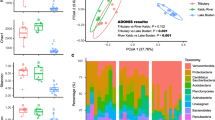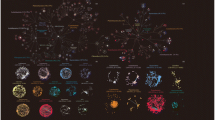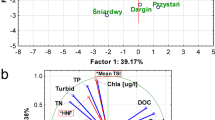Abstract
The hyporheic zone of a river is characterized by being nonphotic, exhibiting chemical/redox gradients, and having a heterotrophic food web based on the consumption of organic carbon entrained from surface waters. Hyporheic microbial communities constitute the base of food webs in these environments and are important for maintaining a functioning lotic ecosystem. While microbial communities of rivers dominated by fine-grained sediments are relatively well studied, little is known about the structure and seasonal dynamics of microbial communities inhabiting the predominantly gravel and cobble hyporheic zones of rivers of the western United States. Here, we present the first molecular analysis of hyporheic microbial communities of three different stream types (based on mean base discharge, substratum type, and drainage area), in Montana. Utilizing 16S rDNA phylogeny, DGGE pattern analysis, and qPCR, we have analyzed the prokaryotic communities living on the 1.7 to 2.36 mm grain-size fraction of hyporheic sediments from three separate riffles in each stream. DGGE analysis showed clear seasonal community patterns, indicated similar community composition between different riffles within a stream (95.6–96.6% similarity), and allowed differentiation between communities in different streams. Each river supported a unique complement of species; however, several phylogenetic groups were conserved between all three streams including Pseudomonads and members of the genera Aquabacterium, Rhodoferax, Hyphomicrobium, and Pirellula. Each group showed pronounced seasonal trends in abundance, with peaks during the Fall. The Hyphomicrobium group was numerically dominant throughout the year in all three streams. This work provides a framework for investigating the effects of various environmental factors and anthropogenic effects on microbial communities inhabiting the hyporheic zone.
Similar content being viewed by others
References
Baker MA, Dahm CN, Valett HM (1999) Acetate retention and metabolism in the hyporheic zone of a mountain stream. Limnol Oceanogr 44:1530–1539
Battin TJ, Wille A, Sattler B, Psenner R (2001) Phylogenetic and functional heterogeneity of sediment biofilms along environmental gradients in a glacial stream. Appl Environ Microbiol 67:799–807
Becker S, Boger P, Oehlmann R, Ernst A (2000) PCR bias in ecological analysis: a case study for quantitative Taq nuclease assays in analyses of microbial communities. Appl Environ Microbiol 66:4945–4953
Böckelmann DBU (2001) Description and characterization of bacteria attached to lotic organic aggregates (river snow) in the Elbe River of Germany and the South Saskatchewan River of Canada. Dissertation. Technischen Universitat Berlin, Berlin, Germany
Borg I, Lingoes J (1987) Mulitdimensional Similarity Structure Analysis. Springer Verlag, New York
Boulton A, Findlay S, Marmonier P, Stanley E, Valett H (1998) The functional significance of the hyporheic zone in streams and rivers. Annu Rev Ecol Syst 29:59–81
Brugger A, Wett B, Kolar I, Reitner B, Herndl G (2001) Immobilization and bacterial utilization of dissolved organic carbon entering the riparian zone of the alpine Enns River, Austria. Aquat Microb Ecol 24:129–142
Brummer IHM, Fehr W, Wagner-Dobler I (2000) Biofilm community structure in polluted rivers: abundance of dominant phylogenetic groups over a complete annual cycle. Appl Environ Microbiol 66:3078–3082
Brunke M, Gonser T (1997) The ecological significance of exchange processes between rivers and ground water. Freshwat Biol 37:1–33
Corpe WA, Jensen TE (1996) The diversity of bacteria, eukaryotic cells and viruses in an oligotrophic lake. 46:622–630
Craft J, Stanford J, Pusch M (2002) Microbial respiration within a floodplain aquifer of a large gravel-bed river. Freshwat Biol 47:251–261
Duineveld BM, Kowalchuk GA, Keijzer A, Van Elsas JD, Van Veen JA (2001) Analysis of bacterial communities in the rhizosphere of Chrysanthemum via denaturing gradient gel electrophoresis of PCR-amplified 16S rRNA as well as DNA fragments coding for 16S rRNA. Appl Environ Microbiol 67:172–178
Edwards KJ, Gihring TM, Banfield JF (1999) Seasonal variations in microbial populations and environmental conditions in an extreme acid mine drainage environment. Appl Environ Microbiol 65:3627–3632
Fellows C, Valett H, Dahm C (2001) Whole-stream metabolism in two montane streams: contribution of the hyporheic zone. Limnol Oceanogr 46:523–531
Ferris M, Ward D (1997) Seasonal distributions of dominant 16S rRNA-defined populations in a hot spring microbial mat examined by denaturing gradient gel electrophoresis. Appl Environ Microbiol 63:1375–1381
Findlay S (1995) Importance of surface-subsurface exchange in stream ecosystems: the hyporheic zone. Limnol Oceanogr 40:159–164
Findlay S, Strayer D, Goumbala C, Gould K (1993) Metabolism of streamwater dissolved organic carbon in the shallow hyporheic zone. Limnol Oceanogr 38:1493–1499
Findlay S, Tank J, Dye S, Valett HM, Mulholland PJ, Mcdowell WH, Johnson SL, Hamilton SK, Edmonds J, Dodds WK, Bowden WB (2002) A cross-system comparison of bacterial and fungal biomass in detritus pools of headwater streams. Microb Ecol 43:55–66
Fischer H, Pusch M (2001) Comparison of bacterial production in sediments, epiphyton and the pelagic zone of a lowland river. Freshwat Biol 46:1335–1348
Fischer HM, Pusch M, Schwoerbel J (1996) Spatial distribution and respiration of bacteria in stream-bed sediments. Arch Hydrobiol 137:281–300
Fowler R, Death R (2001) The effect of environmental stability on hyporheic community structure. Hydrobiologia 445:85–95
Franken R, Storey R, Williams D (2001) Biological, chemical and physical characteristics of downwelling and upwelling zones in the hyporheic zone of a north-temperate stream. Hydrobiologia 444:183–195
Frazar CF (2002) Microbial community production and tolerance in heavy metals polluted sediment. Master’s thesis. The University of Montana, Missoula, MT
Glockner FO, Fuschs BM, Amann R (1999) Bacterioplankton compositions of lakes and oceans: a first comparison based on fluorescence in situ hybridization. Appl Environ Microbiol 65:3721–3726
Glockner FO, Zaichikov E, Belkova N, Denissova L, Pernthaler J, Pernthaler A, Amann R (2000) Comparative 16S rRNA analysis of lake bacterioplankton reveals globally distributed phylogenetic clusters including an abundant group of Actinobacteria. Appl Environ Microbiol 66:5053–5065
Hair JF, Anderson RE, Tatham RL, Black WC (1992) Mulitivariate Data Analysis with Readings, 3rd ed. Macmillan Publishing Company, New York
Halda-Alija L, Hendricks SP, Johnston TC (2001) Spatial and temporal variation of Enterobacter genotypes in sediments and the underlying hyporheic zone of an agricultural stream. Microb Ecol 42:286–294
Hofle MG, Haas H, Dominik K (1999) Seasonal dynamics of bacterioplankton community structure in a eutrophic lake as determined by 5S rRNA analysis. Appl Environ Microbiol 65:3164–3174
Holben WE, Williams P, Saarinen M, Särkilahti LK, Apajalahti JHA (2002) Phylogenetic analysis of intestinal microflora indicates a novel mycoplasma phylotype in farmed and wild salmon. Microb Ecol 44:175–185
Holt JG, Krieg NR, Sneath PHA, Staley JT, Williams ST (1994) Bergey’s Manual of Determinative Bacteriology, 9th ed. Williams and Wilkins, Baltimore
Jackson CR, Churchill PF, Roden EE (2001) Successional changes in bacterial assemblage structure during epilithic biofilm development. Ecology 82:555–566
Kawai M, Matsutera E, Kanda H, Yamaguchi N, Tani K, Nasu M (2002) 16S ribsomal DNA-based analysis of bacterial diversity in purified water used pharmaceutical manufacturing processes by PCR and denaturing gradient gel electrophoresis. Appl Environ Microbiol 68:699–704
Kepner R Jr, Pratt J (1994) Use of fluorochromes for direct enumerations of total bacteria in environmental samples: past and present. Microbiol Rev 58:603–615
Kinner NE, Harvey RW, Blakeslee K, Novarino G, Meeker LD (1998) Size-selective predation on groundwater bacteria by nanoflagellates in an organic-contaminated aquifer. Appl Environ Microbiol 64:618–625
Klappenbach JA, Dunbar JM, Schmidt TM (2000) rRNA operon copy number reflects ecological strategies of bacteria. Appl Environ Microbiol 66:1328–1333
Kruskal JB, Wish M (1978) Multidimensional Scaling. Sage Publications, Beverly Hills, CA
Lee WJ, Patterson DJ (2002) Abundance and biomass of heterotrophic flagellates, and factors controlling their abundance and distribution in sediments of Botany Bay. Microb Ecol 43:467–481
Leff LG, Leff AA, Lemke MJ (1998) Seasonal changes in planktonic bacterial assemblages of two Ohio streams. Freshwat Biol 39:129–134
Lemke MJ, Brown BJ, Leff LG (1997) The response of three bacterial populations to pollution in a stream. Microb Ecol 34:224–231
Lemke MJ, Leff LG (1999) Bacterial populations in an an-thropogenically disturbed stream: comparison of different seasons. Microb Ecol 38:234–243
Lessa EP (1990) Multidimensional analysis of geographic genetic structure. Syst Zool 39:242–252
Macur R, Wheeler J, Mcdermott T, Inskeep W (2001) Microbial populations associated with the reduction and enhanced mobilization of arsenic in mine tailings. Environ Sci Technol 35:3676–3682
Malard F, Ward JV, Robinson CT (1999) An expanded perspective of the hyporheic zone. Verh Internat Verein Limnol 27:1–7
Mathews DH, Sabina J, Zuker M, Turner DH (1999) Expanded sequence dependence of thermodynamic parameters improves prediction of RNA secondary structure. J Mol Biol 288:911–940
Mccaig AE, Glover LA, Prosser JI (2001) Numerical analysis of grassland bacterial community structure under different land management regimens by using 16S ribosomal DNA sequence data and denaturing gradient gel electrophoresis banding patterns. Appl Environ Microbiol 67:4554–4559
Mermillod-Blondin F, Creuze Des Chatelliers M, Marmonier P, Dole-Olivier MJ (2000) Distribution of solutes, microbes and invertebrates in river sediments along a riffle-pool-riffle sequence. Freshwat Biol 44:255–269
Mulholland PJ, Marzolf ER, Webster JR, Hart DR, Hendricks SP (1997) Evidence that hyporheic zones increase heterotrophic metabolism and phosphorous uptake in forest streams. Limnol Oceanogr 42:443–451
Naegeli MW, Uehlinger U (1997) Contribution of the hyporheic zone to ecosystem metabolism in a prealpine gravel-bed river. J N Am Benthol Soc 16:794–804
Nagorski SA (2001) Spatial and temporal variation in the geochemistry of several western Montana streams and rivers. Dissertation. The University of Montana, Missoula, MT
Naiman RJ, Melillo JM, Lock MA, Ford TE, Reice SR (1987) Longitudinal patterns of ecosystem processes and community structure in a subarctic river continuum. Ecology 68:1139–1156
Olsen D, Townsend C, Matthaei C (2001) Influence of reach geomorphology on hyporheic communities in a gravel-bed stream. N Z J Mar Freshwat Res 35:181–190
Orphan VJ, Hinrichs K-U, Ussier W III, Paull CK, Taylor LT, Sylva SP, Hayes JM, Delong EF (2001) Comparative analysis of methane-oxidizing Archaea and sulfate-reducing bacteria in anoxic marine sediments. Appl Environ Microbiol 67:1922–1934
Pernthaler J, Glockner F-O, Unterholzner S, Alfreider A, Psenner R, Amann R (1998) Seasonal community and population dynamics of pelagic bacteria and Archaea in a high mountain lake. App Environ Microbiol 64:4299–4306
Pernthaler J, Posch T, Simek K, Vrba J, Pernthaler A, Glockner FO, Nubel U, Psenner R, Amann R (2001) Predator-specific enrichment of Actinobacteria from a cosmopolitan freshwater clade in mixed continuous culture. Appl Environ Microbiol 67:2145–2155
Pusch M (1997) Community respiration in the hyporheic zone of a riffle-pool sequence. In: Gilbert J, Mathieu J, Fournier F (Eds.) Groundwater/Surface Water Ecotones: Biological and Hydrological Interactions and Management Options. Cambridge University Press, Cambridge, UK, pp 51–56
Pusch M (1999) The metabolism of organic matter in the hyporheic zone of a mountain stream, and its spatial distribution. Hydrobiologia 323:107–118
Pusch M, Fiebig D, Brettar I, Eisenmann H, Ellis BK, Kalpan LA, Lock MA, Naegeli MW, Traunspurger W (1988) The role of micro-organisms in the ecological connectivity of running waters. Freshwat Biol 40:453–495
Pusch M, Schwoerbel J (1994) Community respiration in hyporheic sediments of a mountain stream (Steina, Black Forest). Arch Hydrobiol 130:35–52
Rippka R, Deruelles J, Waterbury JB, Herdman M, Stanier RY (1979) Generic assignments, strain histories and properties of pure cultures of Cyanobacteria. J Gen Microbiol 111:1–61
Ritchie NJ, Schutter ME, Dick RP, Myrold DD (2000) Use of length heterogeneity PCR and fatty acid methyl ester profiles to characterize microbial communities in soil. Appl Environ Microbiol 66:1688–1675
Rooney-Varga J, Devereux R, Evans R, Hines M (1997) Seasonal changes in the relative abundance of uncultivated sulfate-reducing bacteria in a salt marsh sediment and in the rhizosphere of Spartina alterniflora. Appl Environ Microbiol 63:3895–3901
Sambrook J, Fritsch EF, Maniatis T (1989) Molecular Cloning, a Laboratory Manual, 2nd ed. Cold Spring Harbor Laboratory Press, Cold Spring Harbor, NY
Scheiner SM (1993) MANOVA: multiple response variables and multispecies interactions. In: Scheiner SM, Gurevitch J (Eds.) Design and Analysis oncological Experiments Chapman and Hall, New York, pp 94–112
Sekiguchi H, Watanabe M, Nakahara T, Xu B, Uchiyama H (2002) Succession of bacteria community structure along the Changjiang River determined by denaturing gradient gel electrophoresis and clone library analysis. Appl Environ Microbiol 68:5142–5150
Simek K, Pernthaler J, Weinbauer MG, Hornal K, Dolan JR, Nedoma J, Masin M, Amann R (2001) Changes in bacterial community composition and dynamics and viral mortality rates associated with enhanced flagellate grazing in a mesoeutrophic reservoir. Appl Environ Microbiol 67:2723–2544
Smalla K, Wieland G, Buchner A, Zock A, Parzy J, Kaiser S, Roskot N, Heuer H, Berg G (2001) Bulk and rhizosphere soil bacterial communities studied by denaturing gradient gel electrophoresis: plant-dependent enrichment and seasonal shifts revealed. Appl Environ Microbiol 67:4742–4559
Smoot JC, Findlay RH (2001) Spatial and seasonal variation in a reservoir sedimentary microbial community as determined by phospholipid analysis. Microb Ecol 42:350–358
Stanford JA, Ward JV (1993) An ecosystem perspective of alluvial rivers: connectivity and the hyporheic corridor. J N Am Benthol Soc 12:48–60
Suzuki M, Giovannoni S (1996) Bias caused by template annealing in the amplification of mixtures of 16S rRNA genes by PCR. Appl Environ Microbiol 62:625–630
Takeda M, Koizumi J, Yabe K, Adachi K (1998) Thermostable poly(3-hydroxybutyrate) depolymerase of a thermophilic strain of Leptothrix sp. isolated from hot spring. J Ferment Bioeng 85:375–380
Van Hannen E, Mooij W, Van Agterveld M, Gons H, La-anbroek H (1999) Detritus-dependent development of the microbial community in an experimental system: qualitative analysis by denaturing gradient gel electrophoresis. Appl Environ Microbiol 65:2478–2484
Van Hannen EJ, Veninga M, Bloem J, Gons HJ, Laansbroek HJ (1999) Genetic changes in the bacterial community structure associated with protistan grazers. Arch Hydrobiol 145:25–38
Van Hannen EJ, Zwart G, Van Agterveld MP, Gons HJ, Ebert J, Laanbroek HJ (1999) Changes in bacterial and eukaryotic community structure after mass lysis of filamentous Cyanobacteria associated with viruses. Appl Environ Microbiol 65:795–801
Vaque D, Pace M, Findlay S, Lints D (1992) Fate of bacterial production in a heterotrophic ecosystem: grazing by protists and metazoans in the Hudson Estuary. Mar Ecol Prog Ser 89:155–163
Ward JV, Bretschko G, Brunke M, Danjelopol D, Gibert J, Gonser T, Hildrew AG (1998) The boundaries of river systems: the metazoan perspective. Freshwat Biol 40:531–569
Weinbauer MG, Hofie MG (1998) Significance of viral lysis and flagellate grazing as factors controlling bacterioplankton production in a eutrophic lake. Appl Environ Microbiol 64:431–438
Woessner WW (2000) Stream and fluvial plain ground water interaction: rescaling hydrogeological thought. Ground Wat 38:423–429
Yu Z, Mohn WW (1999) Killing two birds with one stone: simultaneous extraction of DNA and RNA from activated sludge biomass. Can J Microbiol 45:269–272
Zhou J, Xia B, Treves DS, Wu L-Y, Marsh TL, O’Neill RV, Palumbo AV, Tiedje JM (2002) Spatial and resource factors influencing high microbiol diversity in soil. Appl Environ Microbiol 68:326–334
Zuker M, Mathews DH, Turner DH (1999) Algorithms and thermodynamics for RNA secondary structure prediction: a practical guide. In: Barciszewski J, Clark BFC (Eds.) RNA Biochemistry and Biotechnology. Kluwer Academic Publishers, Dordrecht, The Netherlands
Author information
Authors and Affiliations
Corresponding author
Additional information
Online publication: 13 June 2003
Rights and permissions
About this article
Cite this article
Feris, K.P., Ramsey, P.W., Frazar, C. et al. Structure and seasonal dynamics of hyporheic zone microbial communities in free-stone rivers of the estern United States. Microb Ecol 46, 200–215 (2003). https://doi.org/10.1007/BF03036883
Received:
Accepted:
Issue Date:
DOI: https://doi.org/10.1007/BF03036883




